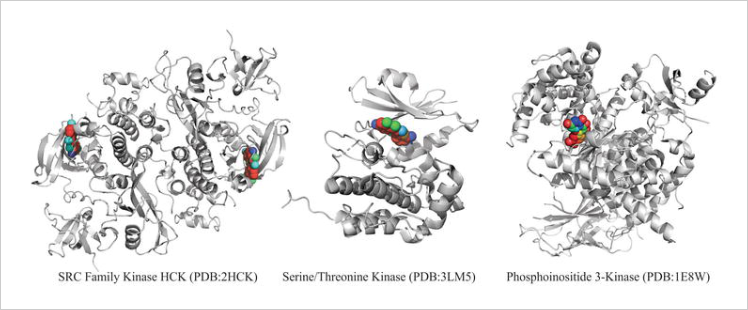quercetin
A polyphenol categorized as a flavonol, one of the five subclasses of flavonoid compounds.
This bioactive phytochemical is biosynthesized and accumulated in tissues and organs of several medicinal plants of the Peruvian Amazon such as :
Quercetin exhibits multifaceted therapeutic applications for multiplicity of unrelated acute and chronic human ailments like :
This multiple health beneficial properties of quercetin are attributed to their particular mechanism of action based on inhibition of several key proteins and enzymes (Figure 5).
For example, a recent research showed that this compound is a potent inhibitor of 25 human serine/threonine kinases [77].
The multitarget inhibitor explains its beneficial pleiotropic effects on humans. This flavonoid-type inhibitor is effective against xanthine oxidase, appropriate for the treatment of :
The inhibitory mechanism is based on the favorable steric complementarity of the conjugated three-ring structure of quercetin with the active site of xanthine oxidase. The enzyme-quercetin binary complex is stabilized by van der Waals forces and hydrogen-bonding interactions with both binding and catalytic amino acid residues, respectively [78, 79].
Recently, Hamilton et al. [80] have demonstrated that quercetin is a competitive inhibitor of glucose uptake by GLUT1. These researchers showed that the inhibitory effect is simply by binding of quercetin to the surface of GLUT1 [80].
Finally, several structural studies by X-ray diffraction have corroborated the inhibitory complex of quercetin with several human protein kinases [81, 82, 83].
This bioactive phytochemical is biosynthesized and accumulated in tissues and organs of several medicinal plants of the Peruvian Amazon such as :
- Annona montana, (Graviola)
- Bauhinia longifolia,
- Bertholletia excelsa, (Brazilian Nut)
- Genipa americana, (huito, vito)
- Inga edulis, (Guaba)
- Mauritia flexuosa, (Aguaje)
- Myrciaria dubia, (Camu Camu)
- Oenocarpus bataua, (patawa)
- Solanum sessiliflorum, (cocona)
- Theobroma bicolor, (Macambo)
- T. cacao, (Cacao)
- T. grandiflorum
Quercetin exhibits multifaceted therapeutic applications for multiplicity of unrelated acute and chronic human ailments like :
- allergy,
- arthritis,
- asthma,
- bacterial and viral infections,
- cancer,
- cardiovascular diseases,
- inflammation,
- obesity,
- diabetes,
- mood disorders,
- neuropathologies,
- and other health problems
This multiple health beneficial properties of quercetin are attributed to their particular mechanism of action based on inhibition of several key proteins and enzymes (Figure 5).
For example, a recent research showed that this compound is a potent inhibitor of 25 human serine/threonine kinases [77].
The multitarget inhibitor explains its beneficial pleiotropic effects on humans. This flavonoid-type inhibitor is effective against xanthine oxidase, appropriate for the treatment of :
- hyperuricemia,
- gout, and
- inflammatory disease states.
The inhibitory mechanism is based on the favorable steric complementarity of the conjugated three-ring structure of quercetin with the active site of xanthine oxidase. The enzyme-quercetin binary complex is stabilized by van der Waals forces and hydrogen-bonding interactions with both binding and catalytic amino acid residues, respectively [78, 79].
Recently, Hamilton et al. [80] have demonstrated that quercetin is a competitive inhibitor of glucose uptake by GLUT1. These researchers showed that the inhibitory effect is simply by binding of quercetin to the surface of GLUT1 [80].
Finally, several structural studies by X-ray diffraction have corroborated the inhibitory complex of quercetin with several human protein kinases [81, 82, 83].
Figure 5. Inhibitory complex of quercetin with selected human kinase targets.


